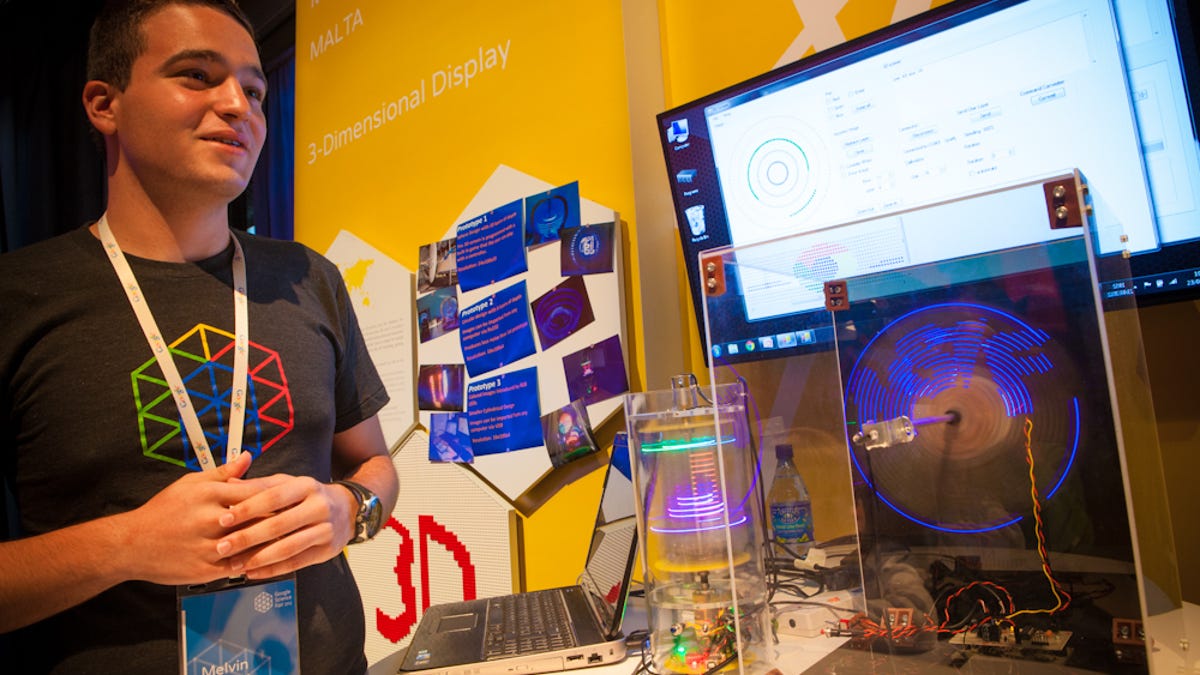Google science fair entrants focus on health, environment
Only 15 teenagers remain from the hundreds of entries from around the world that Google received for its second annual global since fair.

MOUNTAIN VIEW, Calif. -- Google held the final round of its second annual international science fair on Monday morning, hosting 15 contestants from around the world between the ages of 13 and 18.
The science fair this year has grown considerably as not only did Google receive thousands of entries from more than 100 countries, but the program now also accepts entries in not just English but also 14 different languages.
Most of the projects derive from the United States, but there were also contestants present from India, Canada, Spain, the Ukraine, Swaziland, and Malta. Entrants are also judged in three ages groups: ages 13-14, 15-16, and 17-18.
Albert Yu-Min Lin, an emerging explorer at National Geographic and one of the finalist panel judges, explained each finalist has shown that they're working on scientific research far beyond their years -- but with a sense of childhood curiosity that could be necessary for starting such innovative projects in the first place.
Lin added that at National Geographic, there is always the desire to inspire the next generation of scientists and that this global science fair is the "perfect platform" to do that.
"We're enabling that important discussion of what is going on in the world and what can we do to make it better," said Lin.
The themes for the projects on display ranged considerably, focusing on anything and everything from cleaner water to treating methamphetamine addictions. Several of them included elements of cutting-edge technology used for new purposes.
For instance, Brittany Wenger, age 17 from Florida, built a project dubbed the Global Neural Network Cloud Service for Breast Cancer.
Essentially, Wenger crafted an artificial neural network in the Google App Engine cloud that can be tailored and deployed immediately for diagnosing masts faster while being less invasive and more cost-effective.
Wenger was inspired to start this project because she has seen several family members diagnosed with the disease.
"It's something that touches all of us," she continued.
The computer program learns based on mistakes and detects patterns that humans wouldn't be able to identify. Wenger has conducted 7.6 million trials, which she argues proves success rates will increase as the global medical community deposits more data into the cloud network.
So far, she only has data from the University of Wisconsin, but the network already boasts a 99.11 percent rate of successfully diagnosing malignant breast cancer tumors via this program. Wenger's goal is to ultimately get this project "hospital ready" and deployed into more hospitals for beta testing.
Also on the medical technology front, Catherine Wong, age 17 (although she is competing in the 15-16 age group as she entered when she was 16) from Morristown, N.J., designed a mobile phone comparable telemedicine system.
More simply, she developed a platform in which people can send EKG images to diagnosing heart disease using nothing more than Bluetooth on a feature phone.
On display on Monday, Wong was using a basic Motorola feature phone running on Android. The program for running the EKG test was written in Java, saving the results as a JPEG image. Wong explained that most people don't realize the closer degree of access to mobile phones over health care services in Third World countries. Thus, mobile phones (not even smartphones, necessarily) can really present a more cost-effective alternative to non-portable EKG devices and other telemedical systems.
"Engineering can mean the difference between life and death," Wong stated, adding that mobile phones can be used for so many different things we never knew possible.
Some of the other projects tackled more environmental topics. Sumit Singh, age 15 (also competing in the 13-14 age from Lucknow, India, designed a vertical multi-level farming layout to increase crop yields while maintaining a more affordable farm.
Inspired by simply seeing how plants could grow throughout his house, Singh started off with a three-level farm that uses platform towers made from bamboo and mud tiles. His plans have since grown to include at least six levels, but the three crops he started planting were green beans, wheat and chickpeas.
Each tower is spaced apart equally for adequate sunlight. Singh divided the three crops into three observation groups, with the control group on top with the most sunlight and the two experimental groups down below in order to analyze how the crops in each level thrive.
In the end, Singh only found marginal differences between each group, leading to a 66 percent increase in production. Furthermore, the top two levels also provide the benefit of reduced exposure to pests -- especially mice. However, one con is that farmers cannot use heavy machines on the top two levels as towers aren't sturdy enough to withstand them.
The three winners (one from each age group) will be announced during a banquet on Monday evening. All contestants will get a few goodies from Google, including Chromebooks. Beyond that, prizes range from Chromebook kits for winners' schools to scholarship money for college.
This article originally appeared on ZDNet.
http://www.zdnet.com/google-science-fair-entrants-tackle-farming-medical-science-and-more-7000001418/

